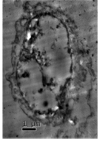Toxicity and environmental risks of nanomaterials: challenges and future needs
- PMID: 19204862
- PMCID: PMC2844666
- DOI: 10.1080/10590500802708267
Toxicity and environmental risks of nanomaterials: challenges and future needs
Abstract
Nanotechnology has gained a great deal of public interest because of the needs and applications of nanomaterials in many areas of human endeavors including industry, agriculture, business, medicine, and public health. Environmental exposure to nanomaterials is inevitable as nanomaterials become part of our daily life, and, as a result, nanotoxicity research is gaining attention. This review presents a summary of recent research efforts on fate, behavior, and toxicity of different classes of nanomaterials in the environment. A critical evaluation of challenges and future needs for the safe environmental nanotechnology are discussed.
Figures








References
-
- Vo-Dinh T. In: Nanotechnology in Biology and Medicine: Methods, Devices, and Applications. Vo-Dinh T, editor. Boca Raton, FL: CRC Press; 2007.
-
- Stewart ME, Anderton CR, Thompson LB, Maria J, Gray SK, Rogers JA, Nuzzo RG. Nanostructured plasmonic sensors. Chem. Rev. 2008;108:494–521. - PubMed
-
- Dahl JA, Maddux BLS, Hutchison JE. Toward greener nanosynthesis. Chem. Rev. 2007;107:2891–2959. - PubMed
-
- Chen X, Mao SS. Titanium dioxide nanomaterials: Synthesis, properties, modifications, and applications. Chem. Rev. 2007;107:2891–2959. - PubMed
-
- Janata J. Introduction: Modern topics in chemical sensing. Chem. Rev. 2008;108:327–328. - PubMed
Publication types
MeSH terms
Substances
Grants and funding
LinkOut - more resources
Full Text Sources
Other Literature Sources
